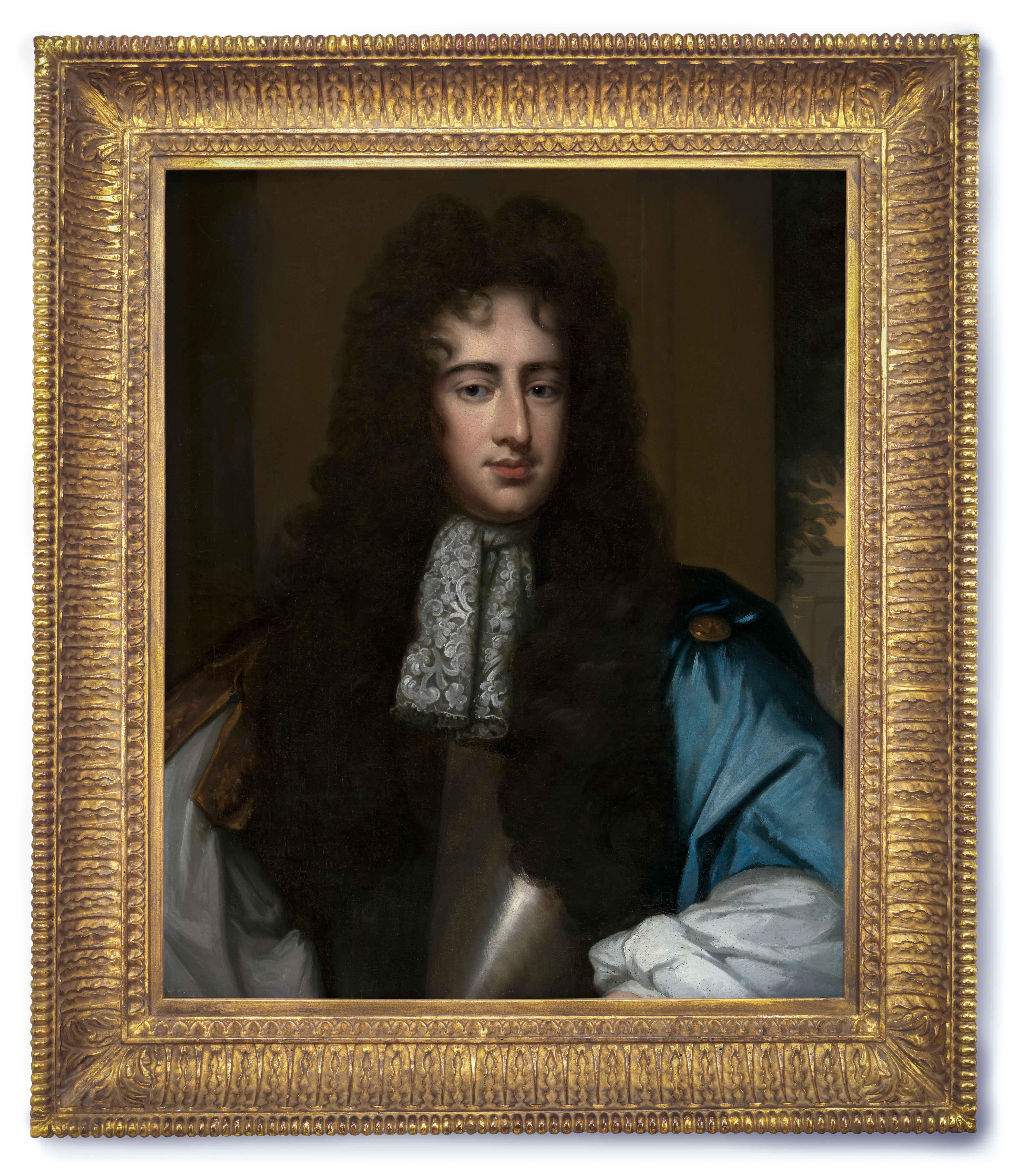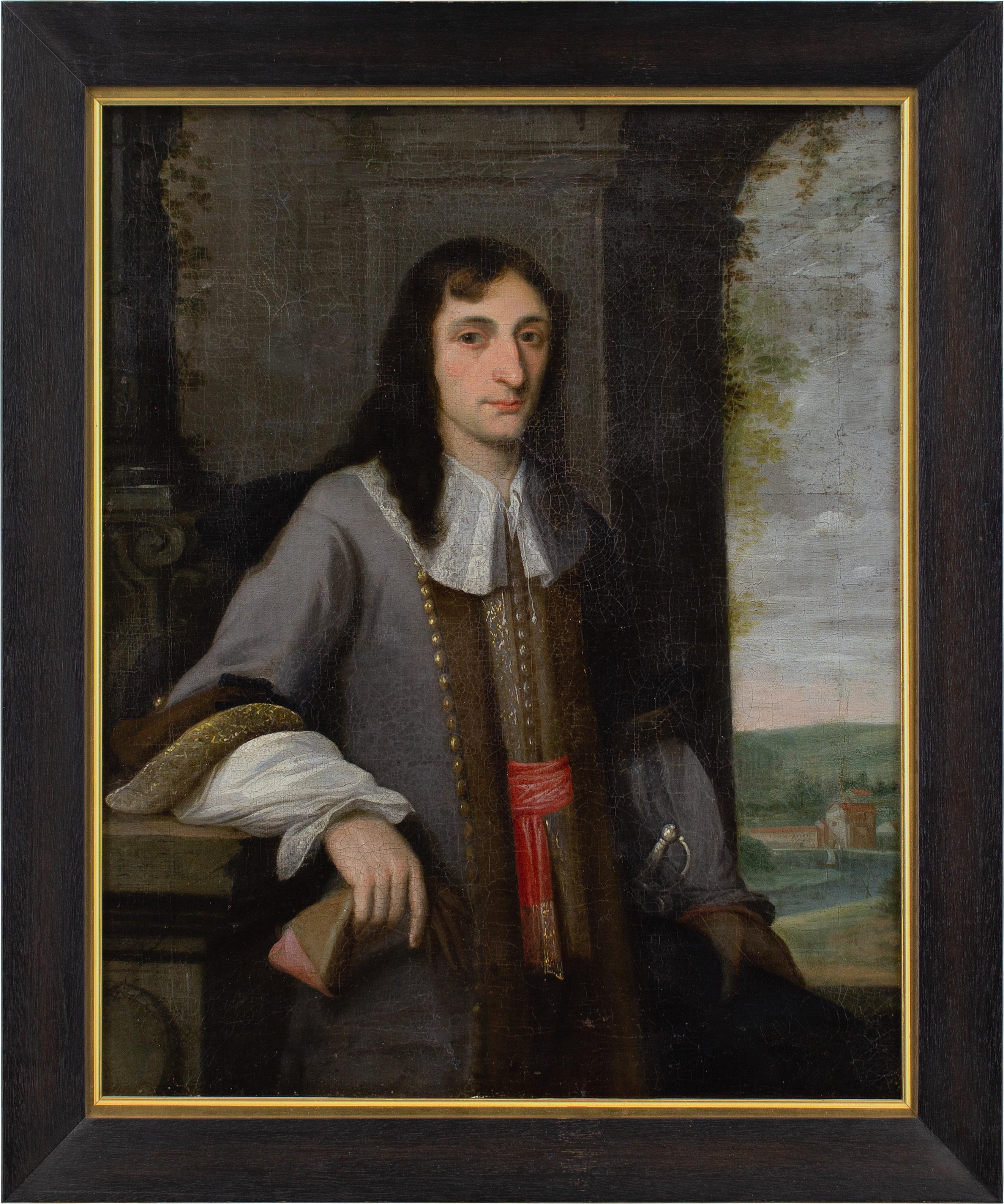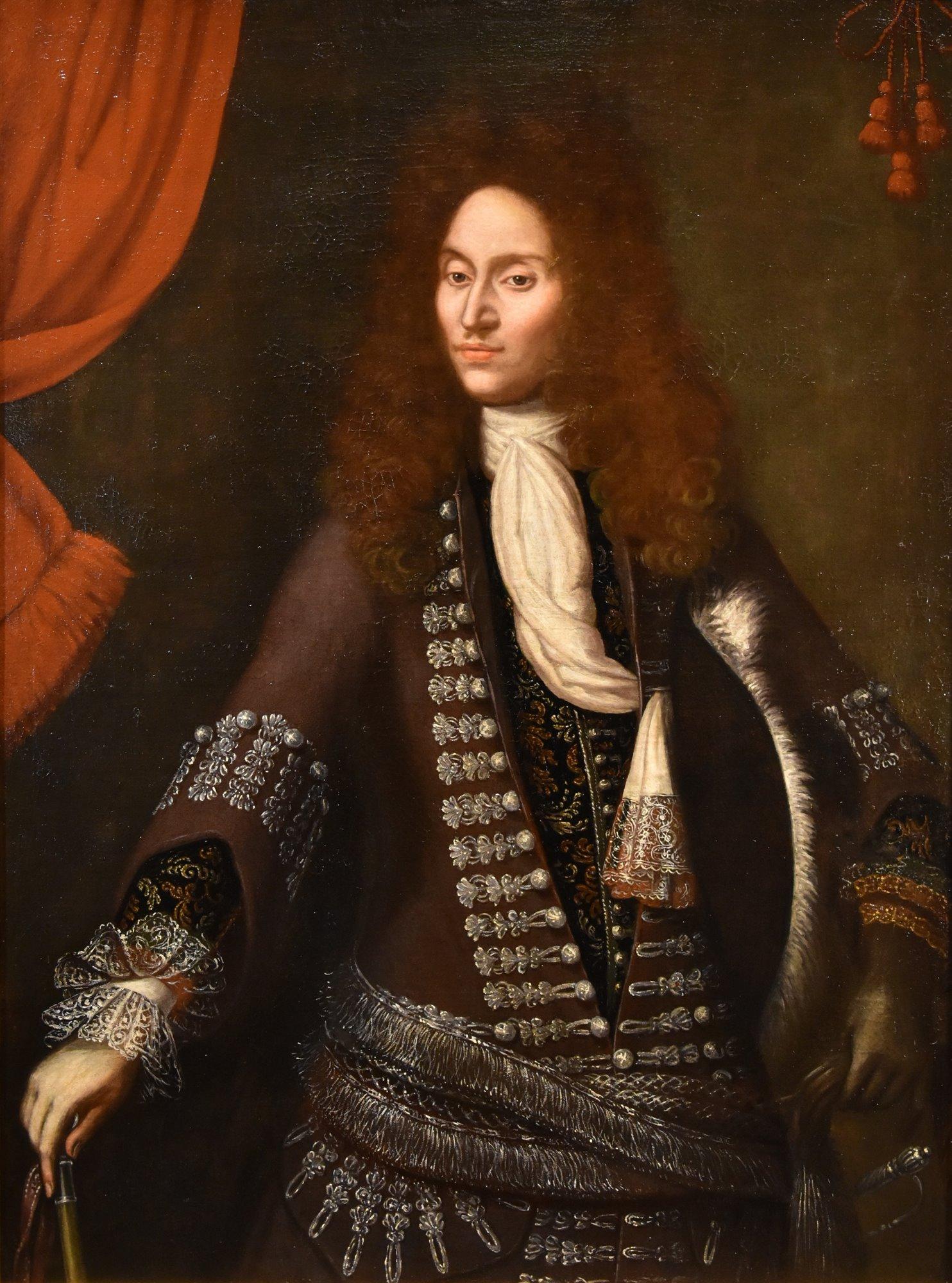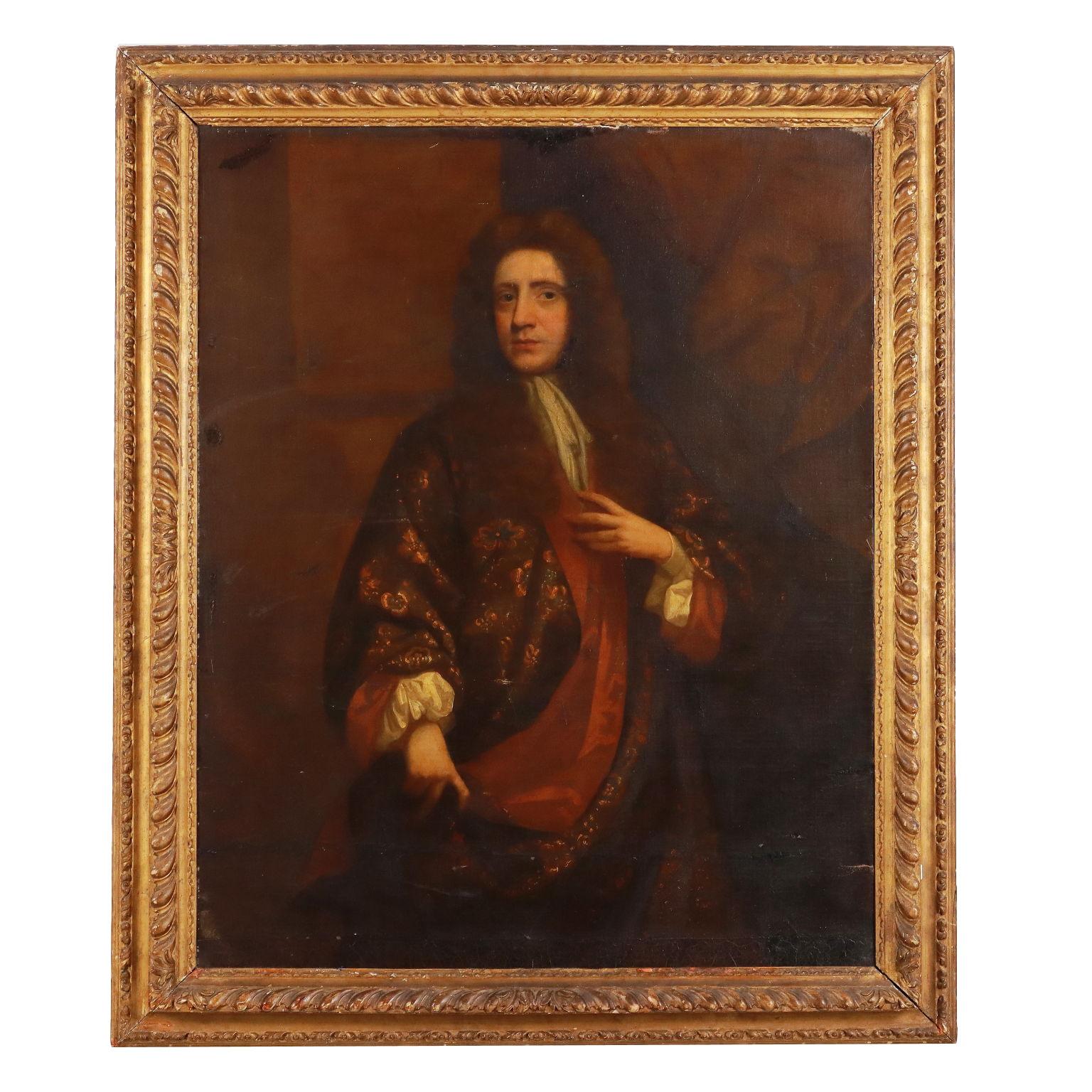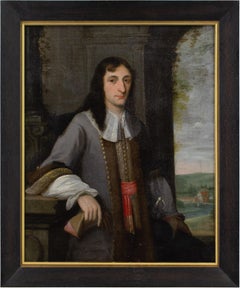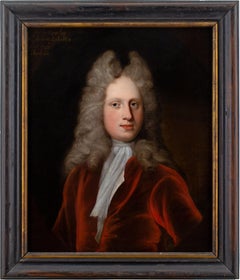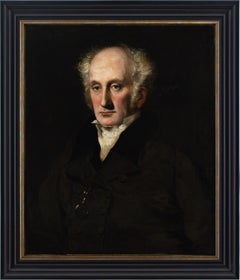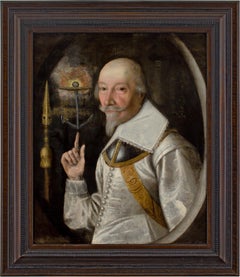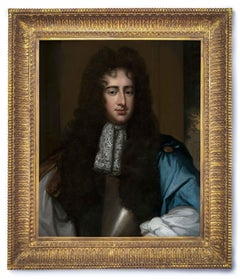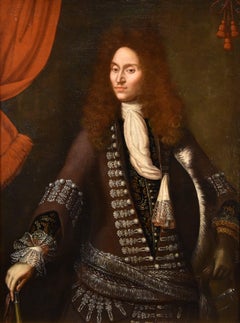Items Similar to Jacques d'Agar (Circle), Portrait Of A Gentleman In A Silk Robe
Want more images or videos?
Request additional images or videos from the seller
1 of 12
Jacques d'Agar (Circle), Portrait Of A Gentleman In A Silk Robec. 1675
c. 1675
$6,311.31
£4,620
€5,424.61
CA$8,867.28
A$9,701.99
CHF 5,006.20
MX$116,180.25
NOK 63,556.05
SEK 59,545.89
DKK 40,510.56
About the Item
This enchanting late 17th-century French oil painting depicts an elegant gentleman in a silk robe with his right index finger on an open book. Stylistically, it’s comparable to the oeuvre of Jacques d'Agar (1640-1715).
Dressed in a rather ostentatious embroidered silk robe, which is seemingly held closed by his left hand, he conveys the air of an enlightened scholar. Behind, a classical column indicates his distinguished lineage, while an open book demonstrates his superior knowledge.
The pages display Latin lettering, which appears to reference Neptune, the god of the sea, Pan, the god of the wild, and Diana, the goddess of childbirth and fertility. It also reads ‘Henry Rules’, which presumably relates to the French King Henry IV, who was raised in the Protestant faith.
Given the date of the piece, it’s conceivably a hidden message as to the sitter’s political leanings and possibly a criticism of King Louis XIV. Is this a gentleman of Huguenot descent perhaps?
Jacques d'Agar was born in Paris, trained under Jacob Ferdinand Voet and became ‘painter-in-ordinary’ to the King and his court. As a protestant, he left France following the revocation of Henry IV’s ‘Edict of Nantes’ in 1682, which led to a mass exodus of Huguenots.
Held within a beautiful Louis XIV carved giltwood frame with incised strapwork and leaf/flower corners, which is probably original.
Labels & Inscriptions: Stencil on reverse, which possibly relates to a Christie's sale.
Provenance: Private collection, France.
- Creation Year:c. 1675
- Dimensions:Height: 41 in (104.14 cm)Width: 38 in (96.52 cm)
- Medium:
- Movement & Style:
- Circle Of:Jacques d'Agar (1640 - 1716, French)
- Period:1670-1679
- Condition:Cleaned. Revarnished. Canvas relined. Faint stretcher mark. Fine craquelure throughout. The paint layer is stable. Frame with various marks and showing its age.
- Gallery Location:Cheltenham, GB
- Reference Number:1stDibs: LU2328215537222
About the Seller
5.0
Platinum Seller
Premium sellers with a 4.7+ rating and 24-hour response times
Established in 2017
1stDibs seller since 2023
246 sales on 1stDibs
Typical response time: 3 hours
- ShippingRetrieving quote...Shipping from: Cheltenham, United Kingdom
- Return Policy
Authenticity Guarantee
In the unlikely event there’s an issue with an item’s authenticity, contact us within 1 year for a full refund. DetailsMoney-Back Guarantee
If your item is not as described, is damaged in transit, or does not arrive, contact us within 7 days for a full refund. Details24-Hour Cancellation
You have a 24-hour grace period in which to reconsider your purchase, with no questions asked.Vetted Professional Sellers
Our world-class sellers must adhere to strict standards for service and quality, maintaining the integrity of our listings.Price-Match Guarantee
If you find that a seller listed the same item for a lower price elsewhere, we’ll match it.Trusted Global Delivery
Our best-in-class carrier network provides specialized shipping options worldwide, including custom delivery.More From This Seller
View All17th-Century Flemish School, Portrait Of A Gentleman In A Justaucorps
Located in Cheltenham, GB
This fine late 17th-century Flemish portrait depicts a distinguished gentleman wearing a justaucorps, black cloak, white shirt, vest, leather gloves, and breeches. He’s carrying a wi...
Category
1670s Old Masters Portrait Paintings
Materials
Canvas, Oil
Michael Dahl (Circle), Portrait Of Thomas Stanley
Located in Cheltenham, GB
This early 18th-century English School portrait depicts Thomas Stanley wearing a striking red velvet suit, white cravat and powdered periwig. Fashionable, yet elegantly refined. On t...
Category
Early 18th Century English School Portrait Paintings
Materials
Canvas, Oil
John Robert Wildman, Portrait Of A Gentleman
Located in Cheltenham, GB
This mid-19th-century oil painting by British artist John Robert Wildman (1788-1843) depicts a gentleman wearing a dark brown frock coat with waistcoat, white shirt and cravat. He be...
Category
1840s Portrait Paintings
Materials
Canvas, Oil
Early 17th-Century Dutch School, Portrait Of A Swedish Officer
Located in Cheltenham, GB
This heavily-inscribed early 17th-century half-length portrait depicts an officer wearing a silk doublet with a gorget, presented in a feigned oval. He’s standing alongside an anchor...
Category
17th Century Baroque Portrait Paintings
Materials
Canvas, Oil
Early-18th Century French School, Ex-Voto Portrait With Emilian Jacobin
Located in Cheltenham, GB
This splendid early 18th-century French oil painting represents an ‘ex-voto’ with Emilian Jacobin and a depiction of the Virgin Mary with Christ and angels.
Ex votos are votive offe...
Category
1710s French School Portrait Paintings
Materials
Oil, Canvas
Mid-18th-Century German School, Portrait Of An Aristocrat In Armour
Located in Cheltenham, GB
This mid-18th-century half-length German portrait depicts a middle-aged aristocrat wearing armour and a wig.
Despite his heavily-clad appearance, it’s likely that this rather noncha...
Category
1750s Old Masters Portrait Paintings
Materials
Oil, Canvas
You May Also Like
Portrait of Gentleman, Sir Henry Hobart, Blue Cloak & cravat, Wissing oil canvas
By Willem Wissing
Located in London, GB
Portrait of a Gentleman, Sir Henry Hobart Blue Cloak and cravat c.1683-1684
Attributed to Willem Wissing (1656-1687)
This impressive portrait, presented by Titan Fine Art, depicts t...
Category
17th Century Old Masters Portrait Paintings
Materials
Cotton Canvas, Oil
Oval Portrait of a Gentleman - French Old Master c1700 art oil painting
By Nicolas de Largillière
Located in Hagley, England
This superb French Old Master oval portrait oil painting is attributed to circle of Nicolas de Largilliere. Painted circa 1700 it is a half length portrait of a gentleman in a red co...
Category
Early 1700s Old Masters Portrait Paintings
Materials
Oil
$6,557 Sale Price
20% Off
English 17th century portrait of John Ludford Esquire
By Mary Beale
Located in Bath, Somerset
Portrait of John Ludford (1653-1681), wearing a lace jabot and brown and gold trimmed cloak in a feigned stone oval cartouche. Inscribed 'John Ludford, Esq, nat. 14th March 1653, Ob,...
Category
Late 17th Century Baroque Portrait Paintings
Materials
Canvas, Oil
$12,021 Sale Price
20% Off
Portrait Gentleman Wright Man 17th Century Paint Oil on canvas Old master
Located in Riva del Garda, IT
John Michael Wright (London, 1617 – London, 1694)
Portrait of a gentleman in ceremonial dress
Oil on canvas 127 x 94 cm. In a gilded frame 140 x 106 cm.
This charming port...
Category
17th Century Old Masters Paintings
Materials
Oil
Dipinto Ritratto maschile con Veste a Fiori, XVIII secolo
Located in Milan, IT
Olio su tela. Scuola italiana del XVIII secolo.
Nel ritratto di questo gentiluomo spicca in particolare la veste da camera realizzata in un elegante tessuto fiorato, nelle tonalità d...
Category
18th Century Other Art Style Portrait Paintings
Materials
Oil
Mary Beale (circle) Portrait Painting of Sir John Pettus
By (Circle of) Mary Beale
Located in York, GB
A very fine oil on canvas of Sir John Pettus ,circle of Mary Beale 17th century
Wearing a red cloak and a black tunic with white collar. His coat of arms to the right.Unsigned
Housed in a gilt frame, the size overall being 85 x 74 cm whilst the painting is 76 x 63.5cm
In overall excellent condition.
There is a wealth of history about the sitter online , below is a brief resume
John Pettus
Sir John Pettus (1613–1690) was an English royalist, politician and natural philosopher. Pettus was an expert on metallurgy and became a deputy governor of the royal mines in England and Wales under Charles I and II. He is known for the first English translation of the work of the German metallurgist Lazarus Ercker.
Pettus’s grandfather was a wealthy Norwich merchant ,he purchased the manor of Rackheath in 1590 and represented the city in 1601 and 1604-10. Although a younger son, Pettus inherited the manors of Chediston and Wenhaston, He married well; but even before the Civil War most of his estate was mortgaged, and his wife’s expectations were never realized, owing to her father’s misfortunes as leader of the City Royalists. Pettus became a servant to Charles I, and took part in the farcical royalist attempt on Lowestoft in March 1643, but was exchanged after nearly a year in prison. It is unlikely that he resumed command of his regiment, such as it was, since he ‘continued inoffensive till the taking of Bristol’ by the New Model Army...
Category
17th Century Old Masters Portrait Paintings
Materials
Oil
More Ways To Browse
Antique Silk Paintings
King Louis Xiv
Silk Painting Framed
Henry Iv
Silk Paint Framed
French Robe
17th Century French Painting
Antique Silk Robe
God Pan
Black Silk Robe
Embroidered Silk Robe
Jacob Ferdinand Voet
Sara Scribner
Small Oil Portrait
Used Satellite Dish
Will Cotton
1888 Oil Portraits
1940s British Painting
